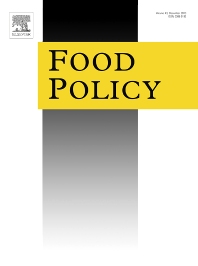Last updated on May 11, 2014
I began a three-year term as associate editor over at Food Policy at the end of last year, which means that I handle submissions in my areas of expertise, deciding which manuscripts get reviewed and which ones get desk rejected, selecting reviewers for those manuscripts that do get reviewed, and so on.
Once again, I wanted to feature a few articles from the latest issue of the journal. There is nothing special about those articles beyond the fact that I thought they would be of interest to readers of this blog.
Farm production diversity is associated with greater household dietary diversity in Malawi: Findings from nationally representative data, by Andrew D. Jones et al.
Highlights:
- We model the influence of farm production diversity (FPD) on dietary diversity (DD)
- We measure FPD using the Simpson’s Index, a metric of species richness and evenness.
- FPD was consistently positively associated with DD.
- FPD was especially strongly associated with consumption of legumes and vegetables.
- Gender, wealth, and control of decisionmaking influence the FPD/DD relationship.
Farmer groups and input access: When membership is not enough, by Lenis Saweda O. Liverpool-Tasie.
- We analyze a fertilizer voucher program administered differently in two Nigerian states.
- We model the process of participation in the voucher program separately from the extent of participation.
- How groups were used to distribute inputs affected the amount of fertilizer participants received.
- Better connected farmers received more fertilizer when distribution was done at group level.
- Though groups are useful for coordination, input distribution at the individual level is preferred.
Marketing margins and the welfare analysis of food price shocks, by David Dawe and Irini Maltsoglou.
- Marketing costs matter for assessing welfare impacts of food price increases.
- Assuming proportional marketing costs is biased to finding negative impacts.
- The bias from assuming proportional marketing costs is large in many cases.
Examining the link between food prices and food insecurity: A multi-level analysis of maize price and birthweight in Kenya, by Kathryn Grace et al.
- We model low birth weight as a response to food price.
- In the model we incorporate local food production estimates and household data.
- Food price increases during pre-pregnancy correlate with reduced low birth weight.
- Food prices and production interact to impact birth weight outcomes.
Does food security matter for transition in Arab countries?, by Jean-François Maystadt et al.
- Based on a dataset from 1960 to 2010, we assess the main determinants of conflicts in the Arab world.
- Food security, threatened by price shocks, emerges as the main driver of conflicts.
- Improving food security is likely to be key for a peaceful transition.
- Recommended policy options include establishing safeguard mechanisms against excessive price volatility, supporting pro-poor growth, and the expanding social safety nets and targeted nutrition programs.
